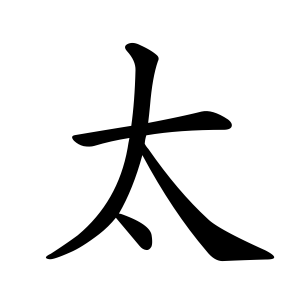太
- large, great, big, excessive;
Etymology
Usage in Korean
태양 (太陽) — the sun
태극 (太極) — the supreme ultimate (yin-yang cosmology)
태자 (太子) — crown prince
태후 (太后) — empress dowager
태고 (太古) — ancient times, primordial era
태평 (太平) — great peace, tranquility
Words that derived from 太
Additional notes
The character 太 carries profound significance in East Asian cosmology.
In Daoist and Confucian philosophy, 太極 (the “Supreme Ultimate”) refers to the source of yin and yang, the dynamic principle generating the universe.
In political titles, 太 was used honorifically to denote exalted figures: 太子 (crown prince), 太后 (empress dowager), and posthumous temple names of emperors (e.g., 太祖, “Great Progenitor”).
It expresses the idea of what is supremely great, ultimate, or foundational, extending beyond mere physical size into the metaphysical realm of order and balance.
